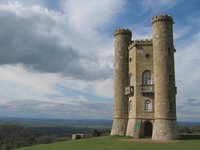Folly
|
|
Missing image
Wimpole_hall_grounds_lake_and_folly.jpg
Wimpole_hall_grounds_lake_and_folly.jpg
The folly at Wimpole Hall, England
In architecture, a folly is an extravagant, useless, or fanciful building, or a building that appears to be something other than what it is.
The term comes from the fact that such structures have often been dubbed "[name of architect or builder]'s Folly", in the sense of foolishness or madness.
Follies are usually found in parks or large grounds of houses and stately homes; they may sometimes have been deliberately built to look partially in ruins. They were especially popular from the end of the 16th century to the 18th century.
The Parc de la Villette in Paris has a number of modern follies by different architects.
Examples include
- The Folly Tower at Pontypool, Wales
- "The Cage" at Lyme Park
- Belvedere Castle, Central Park, New York
- Lucy the Elephant, Margate City, New Jersey
- Peckforton Castle
- Severndroog Castle, Shooter's Hill, south-east London
- Rushton Triangular Lodge, Northamptonshire (16th century)
- Wentworth Woodhouse, several follies in the grounds
- Stowe School, several follies in the grounds
- The Ashton Memorial, Lancaster, England
- Broadway Tower, The Cotswolds, England
- Désert de Retz, folly garden in Chambourcy near Paris, France (18th century)
- Hawkstone Park, follies and gardens in Shropshire, England
External link
- Follies in the English Landscape (http://www.britainexpress.com/History/follies.htm)

